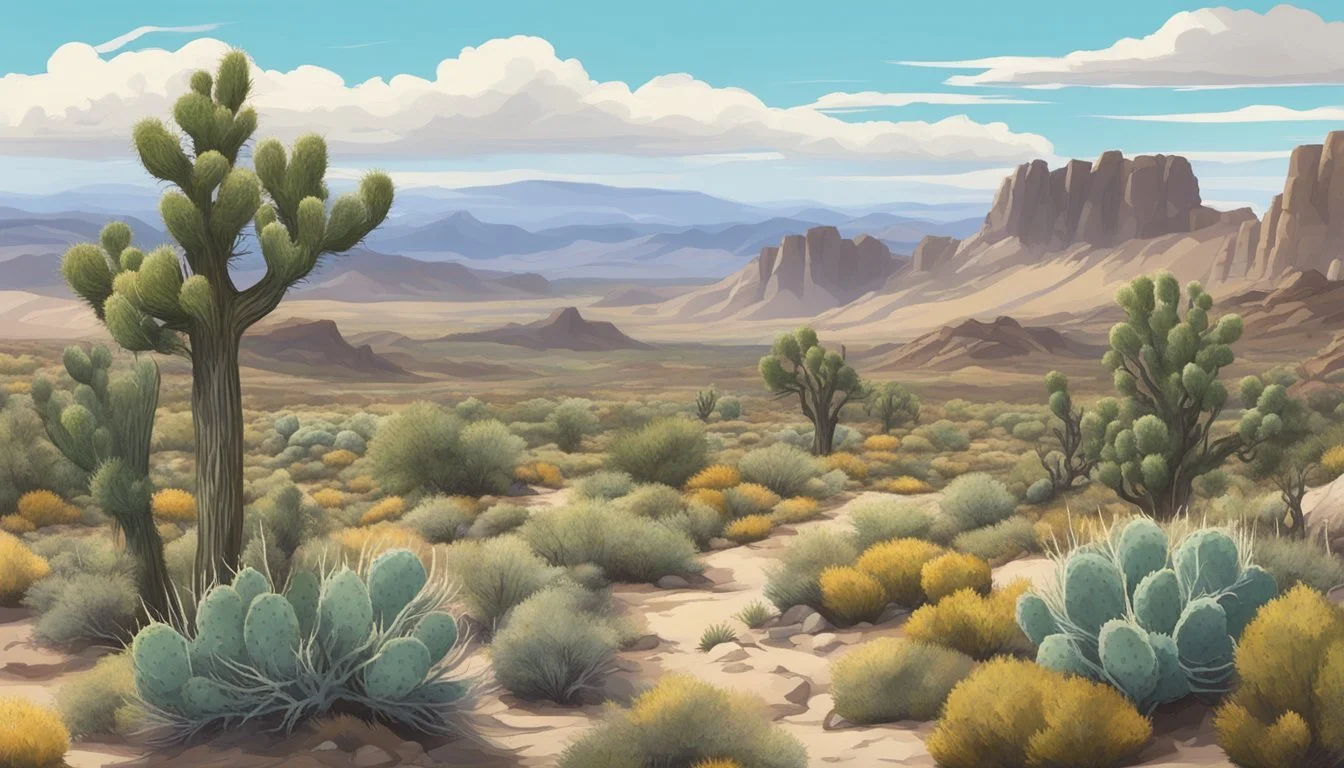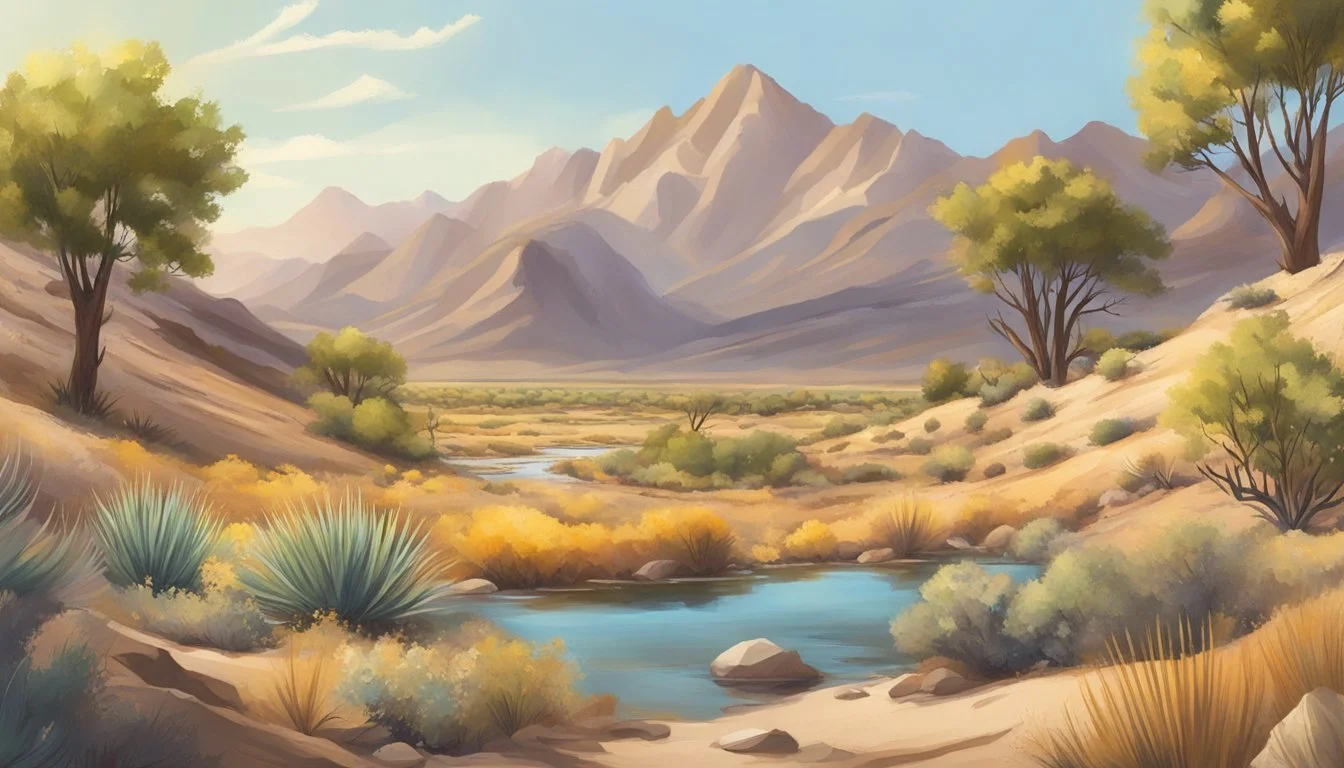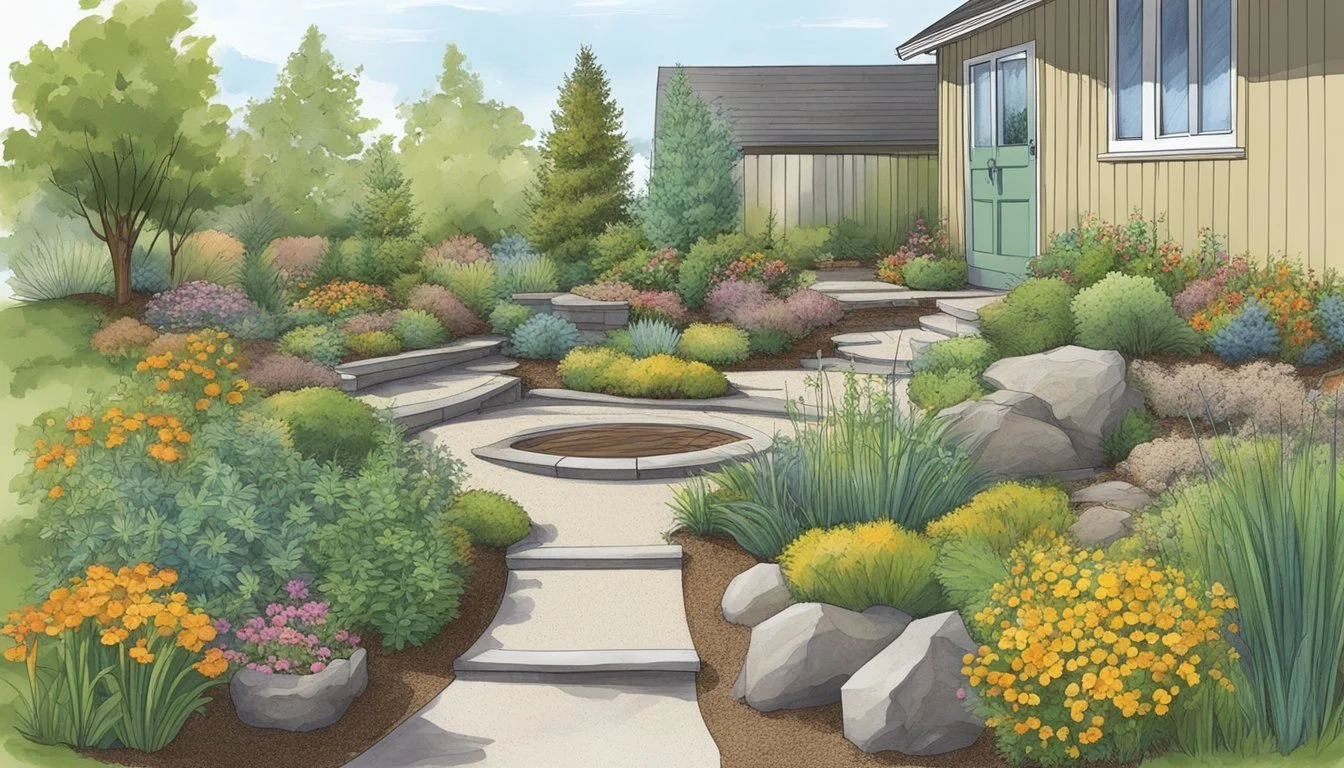Drought-Tolerant Plants in Idaho
Best Varieties for a Resilient Garden
Drought-tolerant plants have become an essential part of landscaping in Idaho, particularly given the state's varying climates and occasional water scarcity. These plants not only thrive with minimal irrigation but also contribute to xeriscaping, an environmentally responsible approach to landscaping that reduces the need for supplemental water from irrigation. Idaho's native and adaptive flora includes a range of perennials, shrubs, and grasses, which have evolved to withstand dry conditions without sacrificing the aesthetic appeal of the green spaces they occupy.
Incorporating water-thrifty plants suitable for Idaho's climatic zone ensures sustainable garden practices while supporting local ecosystems. With careful selection, homeowners and gardeners can create vibrant, low-maintenance landscapes that are resilient against drought. Examples include the deeply-rooted Bluebunch wheatgrass, known for its drought resistance, and the aromatic Sagebrush, which prevails once established. These species play a pivotal role in the natural environment, providing nourishment and habitat for native wildlife.
The concept of xeriscaping in Idaho extends beyond the conservation of water resources; it also champions the preservation of the state's natural beauty and the provision of habitats for pollinators. Embracing native Idaho species in the landscape fosters a symbiotic relationship with the local flora and fauna, ensuring a thriving, sustainable ecosystem. Through the strategic selection of drought-resistant vegetation, Idaho's landscaping practices display an intelligent and respectful response to the environmental challenges posed by the region's climate.
Understanding Drought Tolerance
In the diverse landscapes of Idaho, the ability of plants to withstand water scarcity—drought tolerance—is crucial. This section will explore the characteristics and significance of drought-tolerant species, their physiological mechanisms, and adaptation strategies in Idaho's varied climate zones.
Defining Drought-Tolerant Plants
Drought-tolerant plants are species specifically adapted to survive in conditions of limited water availability. They often display unique features that minimize water loss or maximize water uptake.
Importance in Idaho's Climate
Idaho's climate, which spans USDA hardiness zones 3 through 7, necessitates plant species capable of enduring periods of drought. Drought-tolerant plants contribute to sustainable landscaping by reducing the need for irrigation, a significant consideration in arid and semi-arid regions of the state.
Basics of Plant Physiology
The physiological basis of drought tolerance in plants involves a suite of structural and functional adaptations. Effective water management strategies, such as deep root systems or reduced leaf surface area, allow these plants to maintain cellular integrity and photosynthesis under water stress.
Adaptation Strategies
To thrive in dry conditions, drought-tolerant plants have evolved various adaptation strategies. Plants might employ mechanisms like osmolyte metabolism enhancement and secondary metabolite synthesis to improve their resilience against drought-induced damage. These biological tactics are vital for survival in Idaho's challenging climates.
Native Drought-Tolerant Plants of Idaho
Idaho's diverse climate demands plants with resilience to dry conditions. This section identifies native species expertly adapted to thrive with minimal water.
Grasses and Groundcovers
Grasses well-suited to Idaho's arid regions include:
Bluebunch Wheatgrass (Pseudoroegneria spicata): A staple for water-wise landscaping, it sustains local wildlife and resists drought.
Sagebrush (Artemisia tridentata): This iconic Western grass adapts superbly to dry soils, often dominating the high desert.
Groundcovers like Creeping Oregon Grape (Mahonia repens) offer evergreen beauty and drought tolerance, while Buckwheat varieties furnish hardy solutions for ground coverage.
Shrubs and Bushes
Native shrubs capable of withstanding Idaho's dry spells encompass:
Fern Bush (Chamaebatiaria millefolium): A fragrant choice that thrives with little water.
Rubber Rabbitbrush (Ericameria nauseosa): Blooms bright yellow flowers, requires minimal moisture.
Serviceberry (Amelanchier alnifolia): Provides both lovely spring blossoms and edible fruit.
Shrubs like the Oregon Grape (Mahonia aquifolium) and Bitterbrush (Purshia tridentata) are excellent for low-water landscapes, offering both foliage interest and wildlife support.
Deciduous and Evergreen Trees
Deciduous trees like the Water Birch (Betula occidentalis) and Rocky Mountain Maple (Acer glabrum) exhibit splendid fall colors and show remarkable drought resilience.
Evergreens such as:
Western White Pine (Pinus monticola): Majestic in stature, suited to Idaho's varying climates.
Pinyon Pine (Pinus edulis): A smaller pine that is impressively drought resistant.
These trees, including the Western Larch (Larix occidentalis) and Douglas Fir (Pseudotsuga menziesii), provide year-round structure and habitat for Idaho's ecosystems.
Designing a Drought-Resistant Landscape
Creating a landscape resilient to water scarcity involves careful planning and selecting the appropriate flora and hardscape elements. It’s important to utilize design principles and plant selections suited to Idaho’s climate, while also considering how non-plant elements can enhance the sustainability and aesthetics of your garden.
Planning and Design Principles
When designing a drought-tolerant landscape, it's crucial to assess the local climate and soil conditions. Irrigation needs can be minimized by utilizing water-conserving landscape principles, such as grouping plants with similar water requirements and creating zones based on exposure to the sun and shade patterns. Designing for movement with curved paths and selecting plants that add color and line to a garden can create a visually pleasing landscape that also conserves water.
Selecting the Right Plants
Plants chosen for a drought-resistant landscape in Idaho should thrive in dry conditions without requiring frequent watering. Shade-tolerant species can be planted in areas with less sun, reducing evaporation rates. Select native species or those adapted to Idaho's climate, as they typically require less maintenance and water. Plants that serve as pollinator gardens not only conserve water but also support local wildlife.
Incorporating Non-Plant Elements
The inclusion of rocks and other non-plant elements can reduce the need for irrigated plantings while adding texture and contrast to the landscape. Decorative mulch helps retain soil moisture and reduce weeds. Elements such as dry streambeds or gravel can create attractive focal points and contribute to the movement through the landscape, reinforcing the overall design while aiding in water conservation efforts.
Cultivation and Care
To ensure a thriving drought-tolerant landscape in Idaho, one must consider specific practices for cultivating and caring for plants that maximize water efficiency and promote healthy growth.
Soil Preparation and Improvement
Soil preparation is a pivotal first step in establishing a drought-resistant garden. Idaho's climate necessitates the use of well-draining soil to prevent waterlogging. Incorporating organic matter can improve soil structure and water retention. Testing soil pH and fertility helps in tailoring the amendments for optimal plant growth.
Irrigation and Water Management
Effective irrigation is crucial for water conservation. With climates varying across Idaho, drip irrigation systems provide targeted watering, significantly reducing waste. Newly installed plants may require frequent watering until established, but the ultimate goal is deep, infrequent water applications to encourage deep root growth.
Mulching and Ground Cover
Mulching shields the soil from direct sun, conserving moisture and reducing the need for watering. One can use organic mulches like bark or compost, or inorganic options such as gravel, especially around flower beds. Ground covers also protect and insulate soil while minimizing evaporation from bare ground around plants and turf.
Maintenance and Pruning
Regular maintenance, including pruning, keeps plants healthy and conserves water by eliminating the unnecessary stress on plants. Pruning drought-tolerant species annually promotes air circulation, which is essential to reduce disease incidence and remove unproductive growth.
Benefits of Drought-Tolerant Plants
Incorporating drought-tolerant plants into Idaho's landscapes offers substantial rewards, addressing crucial environmental and practical concerns. They enable gardeners and land managers to maintain verdant spaces while conserving water and supporting diverse ecosystems.
Water Conservation
Drought-tolerant plants are adapted to thrive with less moisture, reducing the need for irrigation. This key trait is particularly valuable in Idaho where water is a precious resource. Such plants can sustain themselves on natural rainfall, allowing for a marked decrease in water usage.
Support for Biodiversity
Native drought-tolerant species provide essential habitat for wildlife, including various pollinators like bees and butterflies. These plants offer food and refuge, which is vital for maintaining local biodiversity. In turn, a robust ecosystem is less prone to imbalances and can support a greater variety of life.
Reducing Garden Pests and Diseases
These resilient plants typically face fewer pest problems and plant diseases. They are well-adapted to Idaho's climatic conditions, making them less susceptible to the issues that commonly affect non-native or less hardy plants. Accordingly, they can create healthier and more sustainable gardens.
Aesthetic and Recreational Advantages
Drought-tolerant gardening contributes to creating leisure areas that require less upkeep. These landscapes can flourish under extreme sun exposure, providing essential shade and enhancing aesthetic appeal. They offer a variety of textures, colors, and forms that remain vibrant, even in the heat of summer.
Plant Profiles
In this section, the focus is on specific drought-resistant species that thrive in Idaho's climate. Each subsection will highlight characteristics such as common name, size, bark texture, and preferred sun exposure for grasses and groundcovers, shrubs, and trees suitable for xeriscaping.
Grass and Groundcover Species
Bluebunch Wheatgrass
Common Name: Bluebunch Wheatgrass
Size: Grows up to 2-3 feet tall
Sun Exposure: Full sun to part shade
Bluebunch wheatgrass is a drought-resistant bunchgrass that has deep root systems, enabling it to access water at greater depths.
Shrub Varieties
Big Sagebrush
Common Name: Big Sagebrush
Size: Can reach up to 12 feet in height
Bark: Features a light gray to white bark
Sun Exposure: Prefers full sun
Regarded for its resilience, big sagebrush is a defining plant of the Intermountain West and thrives in Idaho's arid conditions.
Tree Species Characteristics
Western Juniper
Common Name: Western Juniper
Size: Typically grows 10-30 feet tall
Bark: Has fibrous, shredded bark texture
Sun Exposure: Full sun
This coniferous tree is adapted to survive with minimal water and its presence is common throughout the region's dry landscapes.
Eco-Friendly Gardening Practices
In Idaho, eco-friendly gardening practices emphasize the conservation of resources while fostering a natural and sustainable environment. These methods benefit not only drought-tolerant plants but also the local ecosystem as a whole.
Sustainable Water Usage
Gardeners in Idaho often turn to drought-tolerant plants like succulents and Idaho's native water birch to reduce the need for supplemental watering. Utilizing a xeriscape approach, which includes native and adaptable species such as potentilla and serviceberry, can significantly diminish water consumption. Rain barrels and drip irrigation systems further support water conservation, directing moisture to where it is most needed without wastage.
Natural Pest Control
Instead of relying on chemical pesticides, natural pest control integrates beneficial insects and organic remedies to tackle unwanted pests. Introducing predator species, such as ladybugs, helps manage populations of aphids and other harmful insects. Companion planting with strong-scented herbs can also repel pests, protecting sensitive succulents and other drought-tolerant species.
Wildlife-Friendly Landscaping
To create an inviting habitat for local fauna, wildlife-friendly landscaping is key. Including a variety of plants that offer shelter, shade, and color—such as the serviceberry with its vibrant fall foliage—encourages biodiversity. Water features using water birch logs can serve as drinking spots for birds and small mammals while remaining low-maintenance.
Companion Planting Strategies
Companion planting enriches the soil, wards off pests, and uses space efficiently, benefiting both gardeners and the ecosystem. A well-thought-out arrangement might pair potentilla—a hardy shrub with yellow flowers—beside other perennials to offer contrasting color and texture while conserving water. Similarly, planting nitrogen-fixing legumes near serviceberry trees can naturally fertilize the soil, reducing the need for synthetic additives.
Innovative Use of Drought-Resistant Plants
In Idaho, embracing drought-resistant plants supports sustainable landscaping and conservation. Tactical employment of these plants not only bolsters garden aesthetics but also significantly reduces water usage.
Xeriscaping and Low-Water Garden Design
Xeriscaping has surged in popularity across Idaho, especially in water-conscious cities like Boise. It emphasizes the use of drought-tolerant plants and creative landscaping techniques to minimize irrigation needs. The Idaho Botanical Garden is a testament to how xeriscaping can be both functional and visually appealing, providing a practical blueprint for private and public gardens.
Creating Windbreaks and Living Fences
Xerophytic species serve as excellent windbreaks and living fences, offering a natural barrier against erosive winds while conserving soil moisture. Incorporating native shrubs and trees around properties can create sturdy, self-sustaining windbreaks that enhance privacy and reduce wind speed, which in turn can lead to diminished evaporation rates.
Urban Green Spaces and Street Plantings
Urban areas in Idaho are increasingly deploying drought-resistant plants to greenify public spaces while adhering to water restrictions. These plants add green touches to streetscapes with minimal maintenance, especially important during dry months. Cities leverage these hardy species to improve urban aesthetics and contribute to the creation of healthier wetlands that can manage stormwater effectively.
Rooftop and Vertical Gardens
Rooftop and vertical gardens using drought-resistant plants present innovative solutions to urban challenges by enhancing building insulation and decreasing runoff. These gardens transform underutilized spaces into lush areas, improving air quality and reducing the urban heat island effect. They exemplify high-efficiency usage of space and resources, suitable even in arid environments like Idaho's landscape.
Frequently Asked Questions
Drought tolerance is vital for plants in Idaho's varying climates. This section addresses common inquiries about plant choices for water-efficient gardens.
What are the best drought-tolerant perennials for Idaho gardens?
Perennials like the blanket flower (Gaillardia) and the Lewisia, which are adapted to Idaho's climate, exhibit remarkable drought resistance and thrive in local gardens.
Can you recommend some drought-resistant shrubs native to Idaho?
Native shrubs such as the syringa (Philadelphus lewisii), Idaho's state flower, and the bitterbrush (Purshia tridentata) are well-suited for Idaho's dry conditions.
What trees thrive in Idaho's dry climates?
Trees like the ponderosa pine (Pinus ponderosa) and the quaking aspen (Populus tremuloides) are excellent choices, adapted to survive in less water.
What are some low-water-use plants suitable for xeriscaping in Idaho?
Plants suitable for xeriscaping include the drought-tolerant grasses and perennials like penstemon, with its diverse and colorful species requiring minimal watering.
Which evergreen shrubs can survive drought conditions in Idaho?
Evergreen shrubs such as creeping juniper (Juniperus horizontalis) and mormon tea (Ephedra nevadensis) are resilient under drought stress and maintain year-round foliage.
Are there any shade-loving plants that are also drought-tolerant in Idaho?
Shade-loving plants like the Idaho fescue (Festuca idahoensis) and woodland strawberry (Fragaria vesca) can cope with dry conditions while thriving in lower light environments.








